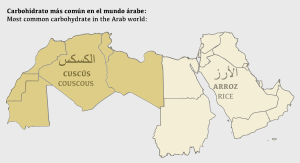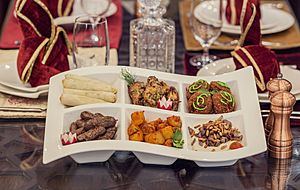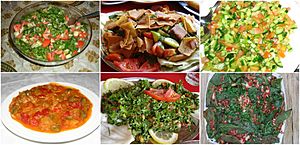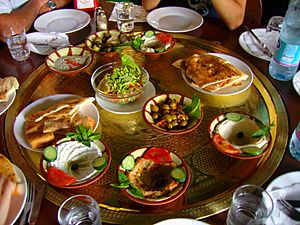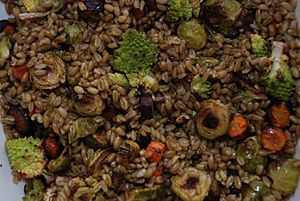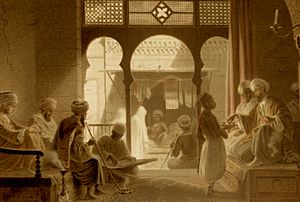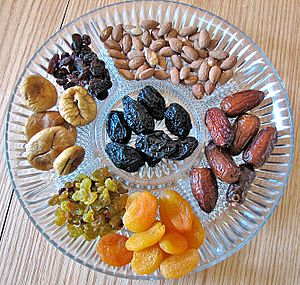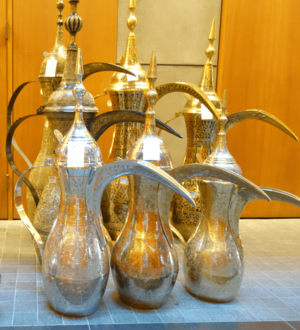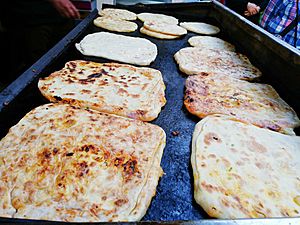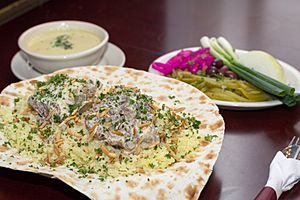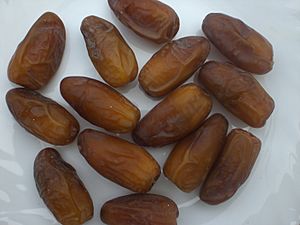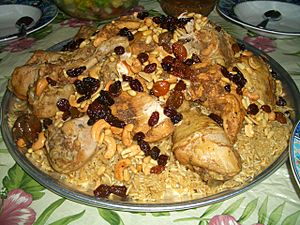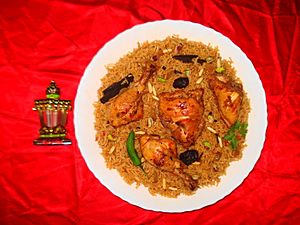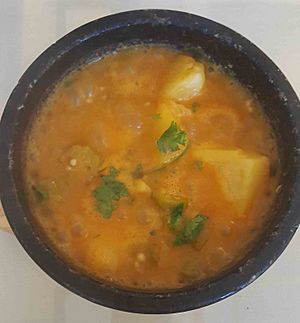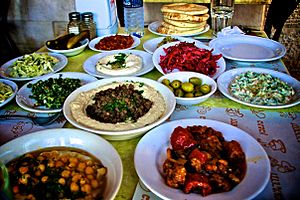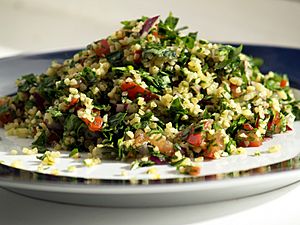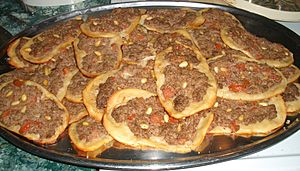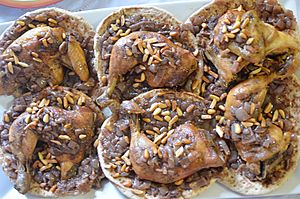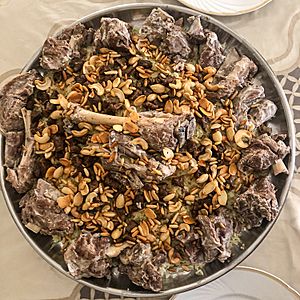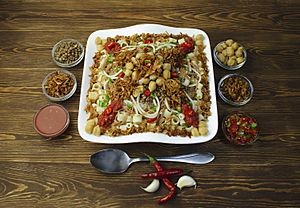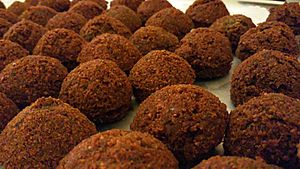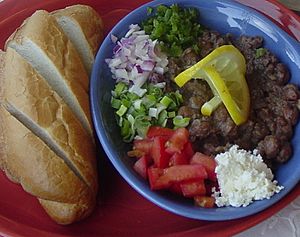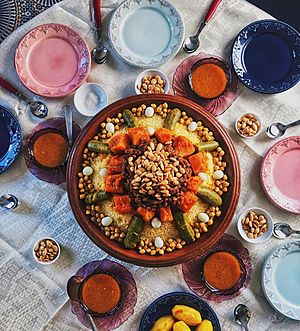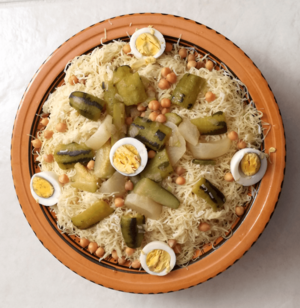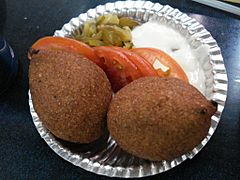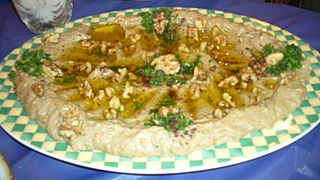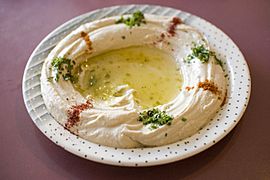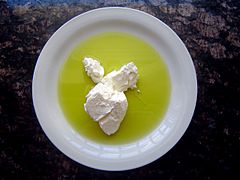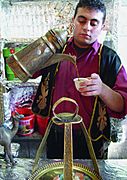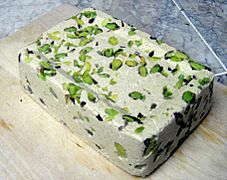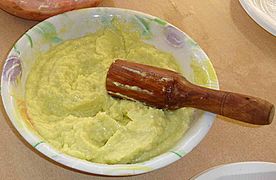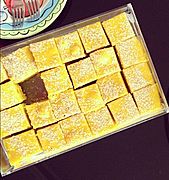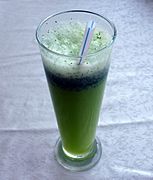Arab cuisine facts for kids
Arab cuisine is the food of Arab people. It includes many different styles of cooking from across the Arab world, from North Africa to the Middle East. These cooking styles are very old, going back hundreds of years. They show how people traded spices, herbs, and foods long ago. While there are many similarities, each region also has its own special traditions. The climate, what grows there, and trade have all shaped these cuisines.
Contents
What Did People Eat Long Ago?
Old Breads
In the past, people made white bread called barazidhaj from good quality wheat flour. It was thicker than another bread called raqaq. This dough was usually made with yeast and baked in a special oven called a tandoor.
Raqaq bread came in two types: labiq, which was soft and thin, and jarmazaj, which was dry and thin, sometimes flavored with tamarisk seeds.
Old Sauces
Many recipes for sauces, called sibagh, have been found in old Arabic cookbooks. For example, a 10th-century cookbook called Kitab al-Tabikh has recipes for sauces served with roasted fish.
One recipe, from a ruler named Ibrahim ibn al-Mahdi, used rue, caraway, thyme, asafetida, and cassia with mustard sauce. Another sauce mixed vinegar-soaked raisins with garlic, walnuts, mustard, and spices like anise.
There were also sauces for chicken dishes, made with ginger, pomegranate, and cloves.
Old Sweets
One very special sweet was lauzinaj, often called the "food of kings." It was made with almonds and became popular in Europe around the 1200s.
- Drenched Lauzinaj was made by filling thin pastry dough with ground almonds (and sometimes pistachios or walnuts). It also had rose water and fancy flavors like mastic or musk. This sweet is thought to be an early version of the famous baklava.
- Dry Lauzinaj was made by cooking ground almonds in boiling honey or sugar until it became like taffy. A raw version, similar to marzipan, mixed almonds with sugar, camphor, musk, and rose water. This sweet was shaped into animals or cut into squares and triangles.
Old Vegetables
People ate many vegetables like leeks, endive, onions, and radishes. Boiled asparagus was often served with olive oil and murri (a fermented sauce). The water from cooking vegetables could be sweetened with honey and flavored with cilantro, rue, anise, and black pepper.
Some vegetables were eaten raw, but many were boiled, such as asparagus, cauliflower, white soy beans, chard, cabbage, carrots, turnips, fennel, and eggplant.
Some vegetable dishes were served cold. For example, cold eggplant with fried onion, fresh herbs, and olive oil, dressed with fermented sauces, vinegar, and caraway. Other cold eggplant dishes included smoked eggplant with ground walnuts or almonds, and spices like saffron or galangal.
What Foods Are Used?
Arab cuisine uses many special foods and spices. Here are some common ones:
- Meats: Lamb and chicken are used most often, followed by beef and goat. Fish is popular in areas near the sea.
- Dairy: Yogurt, buttermilk, and white cheese are widely used. Butter and cream are also common.
- Herbs and Spices: The types and amounts of spices change from region to region.
* Common herbs and spices include sesame, saffron, black pepper, allspice, turmeric, garlic, cumin, cinnamon, parsley, coriander, and sumac. * Popular spice mixes are baharat, ras el hanout, za'atar, and harissa.
- Drinks: Hot drinks are more common than cold ones. Coffee is very popular in the Middle East, and tea is loved in North Africa.
* In some countries like Jordan and Egypt, tea is more popular. Other drinks include horchata and avocado smoothies.
- Grains: Rice is a main food and is used in most dishes. Wheat is used to make bread. Bulgur and semolina are also used a lot.
* Historically, grains were used for porridges and pasta-like dishes. Two types of pasta were known: itriya (short, dry noodles) and rishta (hand-cut fresh noodles).
- Legumes: Lentils are widely used, as are fava beans, peanuts, chickpeas, and various other beans and peas.
- Vegetables: Popular vegetables include carrots, eggplant, zucchini, artichokes, okra, onions, and olives. Potatoes are also eaten.
- Fruits: Pomegranates, dates, figs, oranges, watermelons, grapes, and peaches are favorites.
- Nuts: Almonds, pine nuts, pistachios, and walnuts are often added to dishes or eaten as snacks.
- Greens: Parsley, coriander, and mint are popular for flavoring. Spinach and mulukhiyah (a leafy green) are used in cooked dishes.
- Dressings and Sauces: Common dressings mix olive oil, lemon juice, parsley, or garlic. Tahini (sesame paste) is also popular. Labaneh (strained yogurt) is often seasoned with mint, onion, or garlic and served as a sauce.
How Are Meals Eaten?
Meals in the Arab world usually follow two main patterns: one for most of the year, and a special one for the month of Ramadan, when Muslims fast during the day.
Regular Meals
Breakfast
Breakfast is often a quick meal. It usually includes bread, dairy products like labneh (strained yogurt) and cream, and tea. Cafes might also serve croissants.
Lunch
Lunch is the most important meal of the day, usually eaten between 1:30 pm and 2:30 pm. It's when families gather. Often, salads and mezze (small dishes) are served with the main meal.
The main dish usually has meat, chicken, or fish, with rice, lentils, bread, and cooked vegetables. These are often cooked together in a sauce, like a tomato sauce, called maraqa, and served with rice. Bread is almost always included.
Drinks like shineena (buttermilk), karakaden (hibiscus drink), and fruit juices are common. Fizzy drinks have also become very popular.
Dinner
Dinner is usually a lighter meal. However, these days, dinner has become more important for inviting guests over.
Ramadan Meals
Iftar
Iftar is the meal eaten at sunset to break the fast during Ramadan. It starts with dates, following Islamic tradition.
Next, people have soup, often lentil soup, but also chicken, oats, or freeka (a soup made from whole wheat and chicken broth).
The main dish is usually eaten after a short break for prayer. It's similar to a regular lunch, but cold drinks are often served.
Suhur
Suhur is the meal eaten just before dawn, before the fast begins. It helps people have enough energy to last through the day until sunset.
Ramadan Sweets
During Ramadan, people eat more sweets and fresh fruits between Iftar and Suhur. Some sweets like kanafeh, baklava, and basbousa are eaten all year. But some, like qatayef, are made especially for Ramadan.
Arab Hospitality
Hospitality and generosity are very important in Arab cooking. Meals are often big family gatherings, full of sharing and warmth. Special dinners and celebrations usually include lots of lamb, and almost every occasion involves plenty of Arabic coffee or tea.
Khaleej (Arabian Gulf) Hospitality
Coffee Ceremony
In the Arabian Gulf region, visitors are welcomed with a large table of dried fruits (like figs, dates, apricots), fresh fruits (like melons and pomegranates), nuts, and cakes with syrup. Arabic coffee is very popular, often with spices added. Arabic tea is also a refreshing drink.
Guest Dinners
For dinner, guests can expect a very large platter to share. It will have lots of spiced rice, with spicy lamb, chicken, or both, served separately. There will also be many stewed vegetables, heavily spiced, sometimes with a tomato sauce. Different types of bread are served with regional toppings. Tea and coffee are always offered.
Maghreb (North Africa) Hospitality
Tea/Coffee Ceremony
In the Maghreb region, visitors will find a table with bread-like snacks such as m’semen and baghrir. These are served with honey, rosewater, or olive oil.
There are also many cookies, cakes, and different kinds of nuts. Mint tea is often served in a traditional Maghrebi teapot.
Dinner Guests
For dinner, guests might find a table with different kinds of stews, called marqas or tajines. Dishes like couscous and other semolina-based foods are also common.
These main dishes come with smaller mezze-like plates of salads, sauces, and dips. Breads like m'semen, khobz, and baguette are used to scoop up the stews.
Levantine (Eastern Mediterranean) Hospitality
Coffee/Tea Ceremony
In a typical Levantine Arab home, visitors might see a table full of mezzes, breads topped with spices like za'atar, and nuts. Arabic coffee is very popular, and Arabic tea is also enjoyed in Jordan and Palestine.
Dinner Guests
In the Levant, guests will find a table with different kinds of mezzes, nuts, dips, and oils. Mezzes include hummus, baba ghanoush, falafel, kibbeh, kafta, smoked vegetables, and tabouli salads. Nuts can be almonds or walnuts with different spice coatings. Dips include hummus and olive oil.
Differences in Regions
There are many differences in Arab cuisine from one region to another. For example, mujadara in Syria and Lebanon is different from mujadara in Jordan and Palestine. Some dishes, like mansaf (Jordan's national dish), are only found in certain countries.
Unlike many Western recipes, cinnamon is used in meat dishes, as well as in sweets like baklava. Dishes like tajine and couscous can be made differently from Morocco to Libya, each having its own special way of preparing them.
Regional Arab Cuisines
Arabian Peninsula
The food in Eastern Arabia today mixes influences from the Levant and Yemen.
Ruz al Bukhari (Bukhari rice) is a very popular dish in Saudi Arabia. It's made with spicy tomato sauce, flavored chicken, and a fresh salad.
Kabsa or makbūs is a traditional mixed rice dish from Saudi Arabia. It's made with rice (usually basmati), meat, vegetables, and a mix of spices like black pepper, cloves, cardamom, saffron, cinnamon, and dried lime. Meats can be chicken, goat, lamb, camel, beef, fish, or shrimp. Kabsa is popular around the Persian Gulf.
Yemeni cuisine is a bit different from other Arab cuisines. Chicken, goat, and lamb are eaten more than beef, and fish is mostly eaten near the coast. Cheese, butter, and other dairy products are less common, especially in cities. Tea and coffee are the most popular drinks, often flavored with cardamom or mint.
Saltah is considered Yemen's national dish. It has a brown meat base called maraq, with a dollop of fenugreek foam, and sahawiq (a spicy salsa of chili peppers, tomatoes, garlic, and herbs).
Rice, potatoes, scrambled eggs, and vegetables are often added to saltah. It's eaten with flatbread called mulawah, which is used to scoop up the food.
Other well-known Yemeni dishes include aseed, fahsa, thareed, mandi, and shakshouka.
Mashriq (Eastern Arab World)
Levantine cuisine is the traditional food of the Fertile Crescent, which includes Syria, Lebanon, Jordan, Iraq, Egypt, and Palestine. These areas share many cooking traditions.
Dishes often use olive oil, za'atar, and garlic. Common dishes include many mezze (small dishes) like hummus, falafel, ful, tabouleh, labaneh, and baba ghanoush.
Garlic and olive oil are used a lot, often with lemon juice. Foods are usually grilled, baked, fried, or sautéed in olive oil. Butter and cream are rarely used, except in some desserts.
Vegetables are often eaten raw, pickled, or cooked. This cuisine focuses on fresh ingredients, herbs, and spices, rather than many sauces.
Bedouin Cuisine
Bedouins, who live in the deserts of the Arabian Peninsula and North Africa, eat dates, dried fruits, nuts, wheat, barley, rice, and meat from animals like cows, sheep, and lambs. They also eat dairy products like milk, cheese, and yogurt.
Bedouins use many dried beans, including white beans, lentils, and chickpeas. Common vegetables are those that can be dried, like pumpkins, or those that can handle heat, like eggplants.
They drink a lot of fresh verbena tea, Arabic tea, mint tea, or Arabic coffee. Taking a daily break for drinks is a cherished tradition.
Common breads include khobz and khaleej. Traditional dishes like marqa and tajines (stews) are also made regularly.
Breakfast usually has baked beans, bread, nuts, dried fruits, milk, yogurt, and cheese with tea or coffee. Snacks also include nuts and dried fruits.
Levant (Syria, Lebanon, Jordan, Palestine)
In Palestine and Jordan, people have their own cooking style, roasting meats, baking flatbreads, and making thick yogurt-like pastes from goat's milk.
Musakhan is a common main dish, popular in northern Jordan, Jerusalem, and the West Bank. It uses taboon bread topped with cooked sweet onions, sumac, saffron, and allspice. For big dinners, it can have roasted chickens on a large taboon bread.
Ackawi cheese, a mild, salty cheese with sesame seeds, is used in Palestinian mezze. It's mainly used in kanafeh.
Maqluba is another popular meal in Jordan and central Palestine. Mujaddara, also found in the Levant, is made of cooked green lentils with bulgur sautéed in olive oil.
Mansaf is Jordan's national dish, from the Bedouin people. It's often made for special events like Ramadan or celebrations.
Mansaf is a leg of lamb or large pieces of mutton on markook bread, topped with yellow rice. A thick dried yogurt from goat's milk, called jameed, is poured over the lamb and rice for its special flavor. It's garnished with pine nuts and almonds.
Levantine cuisine is also known for its cheeses like shanklish and halloumi. Kishk is a famous Syrian soup, along with many lentil soups. Lebanese food has many dips like hummus, baba ghanoush, and labneh.
Syrian food can be very vegetarian or full of meat. Lemon, oregano, za'atar, paprika, and other Mediterranean spices are used. Levantine cuisine also includes wines and arak, a drink similar to Greek ouzo.
Iraq/Mesopotamia
Iraq is home to one of the first cookbooks ever, from Baghdad in the 900s. Because of its location, Iraqi cooking shares similarities with both Arab and Persian (Iranian) cuisines. Iraqi food mainly focuses on meat, especially chicken and lamb. The national dish is Masgouf fish, often eaten with grilled tomatoes and onions.
Iraqi cuisine uses more spices than most Arab cuisines. Main crops include wheat, barley, rice, vegetables, and dates. Vegetables like eggplant, okra, potatoes, and tomatoes are common. Chickpeas and lentils are also popular.
Soups and stews are often made and served with rice and vegetables. Biryani, though influenced by Indian food, is milder with different spices and more vegetables. Dolma (stuffed vegetables) is also very popular.
Iraqi cuisine is famous for its very tender kebab and tikka. Many spices, pickles, and amba (a mango pickle) are used.
Egypt
Egypt has a rich cuisine with unique traditions. In coastal areas, people eat a lot of fish. In rural areas, farm products are more common, with duck, geese, chicken, and river fish as main protein sources. While Egyptians eat meat, their cuisine has many vegetarian dishes. Three national dishes of Egypt – ful medames, ta'miya (falafel), and kushari – are usually vegetarian.
Fruits are highly valued in Egypt, including mangoes, grapes, bananas, apples, guavas, and peaches, which are grown locally and are affordable. A famous Egyptian dessert is om ali, like a bread and butter pudding made with puff pastry, milk, and nuts. It's served across the Middle East, especially for special occasions like Eid. Bread, especially eish baladi, is a main food in Egypt.
Africa
Sudan
Sudanese cuisine uses a lot of spices. It has many creative dishes using everyday vegetables to make healthy and tasty stews called mullah. You can find zucchini mullah or spinach mullah. Sudanese food influenced Egyptian and Ethiopian cuisines. Popular dishes include ful medames, shahan ful, hummus, bamya (okra stew), and gurasa (pancake), along with salads and sweets.
Maghreb (Algeria, Libya, Morocco, Tunisia, Mauritania)
Maghreb cuisine is the cooking style of northwestern Africa along the Mediterranean Sea. The main foods are wheat (for khobz bread and couscous), fish, seafood, goat, lamb, beef, dates, almonds, olives, and various vegetables and fruits.
Moroccan cuisine is known for being very diverse. This is because Morocco has traded and connected with the outside world for centuries. Moroccan cuisine is considered one of the best in the Arab world and Africa.
Tunisian cuisine uses a lot of olive oil, spices, tomatoes, fish, and meat. Bread is very important in Tunisian cooking; it goes with almost all dishes and is often used to dip into broths.
Libyan cuisine is influenced by Maghreb and Mediterranean cooking. One popular dish is bazin, an unleavened bread made from barley, water, and salt. Pork is not eaten, following Islamic law. Tripoli, Libya's capital, has Italian influences in its food, so pasta and seafood are common. Southern Libyan food is more traditional Arab and Berber. Common fruits and vegetables include figs, dates, oranges, apricots, and olives.
Libyan cooking, like Tunisian, uses hot spices. Typical foods include bazin, bsisa, couscous, harissa, hassaa, lebrak (stuffed grape leaves), and mbekbka (a unique Libyan soup where pasta is boiled directly in the sauce).
Algerian cuisine is rich and varied, depending on the region and season. It uses many vegetables and grains, which have always been grown in abundance there. Algeria's long history has also brought in foods from different times and places. Couscous is the most famous Algerian dish and is considered a national dish. Algerian cuisine combines vegetables, fruits, spices, meat, fish, seafood, and dried fruits. Vegetables are often used in salads, soups, casseroles, and sauces. Carrots, pumpkins, potatoes, green beans, and eggplants are widely used.
Gallery
- Dishes
See also
 In Spanish: Gastronomía árabe para niños
In Spanish: Gastronomía árabe para niños


